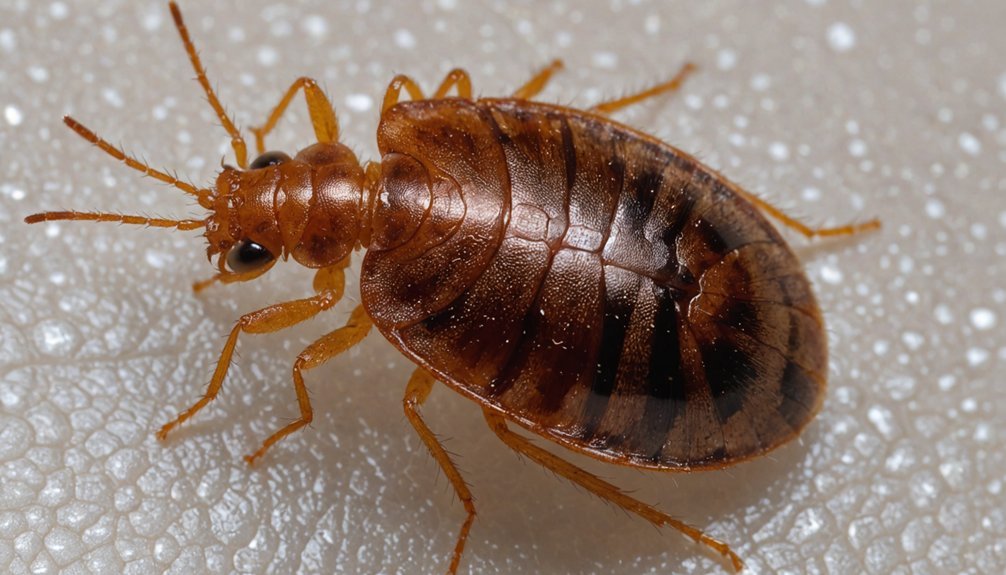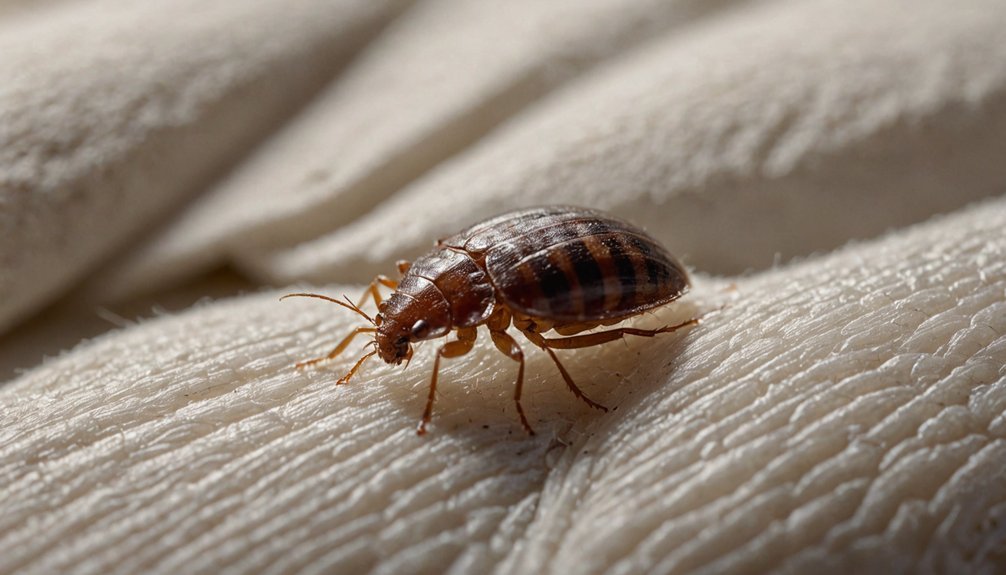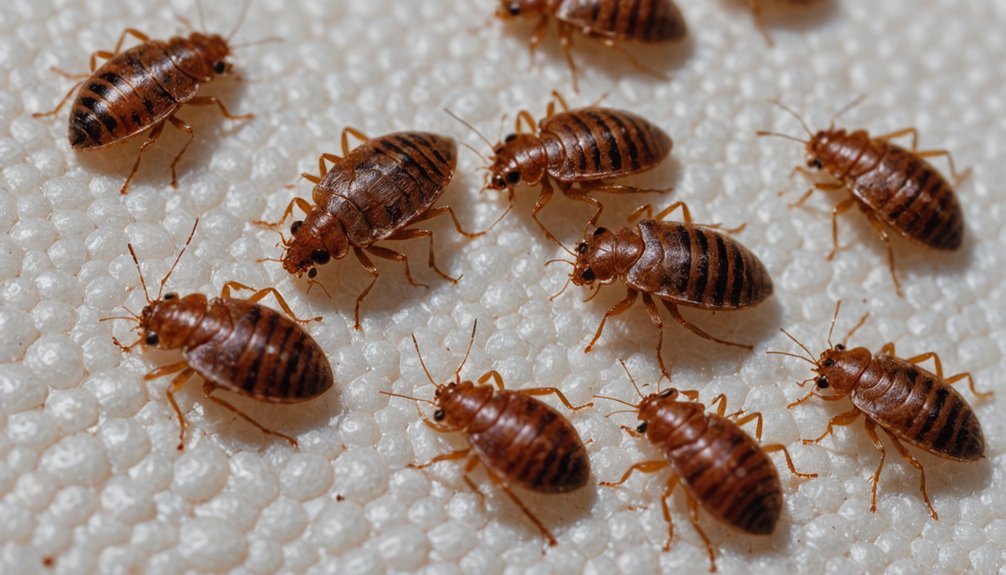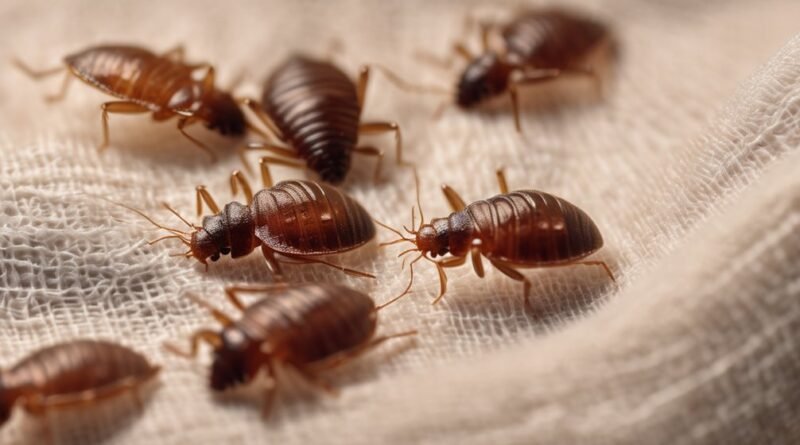Baby Bed Bugs: Pictures & Early Infestation Signs
If you’ve noticed mysterious bite marks or tiny reddish stains on your sheets, you might be dealing with baby bed bugs. These elusive pests can multiply rapidly before you even realize they’re there, turning a small problem into a full-blown infestation. While adult bed bugs are easier to spot, identifying their offspring requires knowing specific signs and behaviors that aren’t always obvious. Understanding what to look for could mean the difference between quick elimination and long-term trouble.
Key Takeaways
- Baby bed bugs are translucent yellow-white and tiny (1-1.5mm), resembling apple seeds, turning bright red after feeding on blood.
- Look for clusters of small red bites (1-3mm) in straight lines on exposed skin, commonly called “breakfast, lunch, and dinner.”
- Check mattress seams and furniture within 8 feet of beds for reddish-brown stains, shed skins, and tiny black fecal spots.
- Newly hatched nymphs must feed every 3-7 days and molt five times before reaching adulthood, leaving transparent skins behind.
- A musty-sweet odor combined with dark spots on bedding and furniture corners indicates potential bed bug presence.
What Baby Bed Bugs Look Like: Size, Shape, and Color

These tiny vampires start their life cycle nearly invisible to the naked eye. At their smallest, baby bed bugs measure just 1-1.5mm – about the size of a grain of salt. They’re nearly translucent or yellowish-white when first hatched, making them incredibly difficult to spot.
As they grow through five nymph stages, you’ll notice their size increasing by roughly 0.5mm each time, reaching up to 4.5mm by the final stage. Their appearance changes dramatically after feeding, turning from pale to bright red as they fill with blood. Each nymph requires a blood meal to molt before progressing to the next stage.
You’ll recognize their flat, oval-shaped bodies resembling tiny apple seeds, complete with six legs and two antennae. While early stages require magnification to spot, later stages become more visible but still blend easily with their surroundings.
Where to Find Baby Bed Bugs in Your Home

Five primary locations serve as hiding spots for baby bed bugs in your home, and knowing where to look can help you detect an infestation early.
You’ll find these pests in upholstered furniture, particularly within seams, folds, and cushions of couches and chairs. They’re also prevalent in beds and surrounding areas, focusing on mattress seams, box springs, and headboards.
Check baseboards and walls carefully, especially cracks, peeling wallpaper, and behind electrical outlets. Window and door frames should be inspected as tight cracks and crevices provide ideal hiding spots for bed bugs.
Don’t forget to inspect your luggage, bags, and clothing storage areas, as these are common entry points.
Finally, examine electronics and furniture joints, where baby bed bugs seek shelter in dark crevices between feedings.
Regular inspection of these areas, combined with thorough cleaning, will help you identify and address infestations quickly.
Common Signs You Have Baby Bed Bugs

If you’re waking up with unexplained bites in clusters or lines, you might be sharing your bed with baby bed bugs.
You’ll notice tiny reddish-brown stains on your sheets and mattress seams where crushed nymphs leave traces of blood after feeding. Careful inspection may reveal transparent shed skins around these areas, as nymphs molt multiple times before reaching adulthood.
A distinct musty-sweet odor coming from your bedroom can confirm your suspicions, as bed bug secretions produce this telltale scent when infestations grow.
Mysterious Bites While Sleeping
Have you ever woken up with mysterious, itchy bites that weren’t there when you went to bed? These small red spots, typically 1-3mm in size, often appear in clusters or straight lines on your exposed skin – a pattern known as “breakfast, lunch, and dinner.”
You’ll likely notice these bites within 12-24 hours after being bitten.
Baby bed bugs, though tiny and translucent, actively seek blood meals just like adults. Their small size makes them particularly difficult to spot, which is why many people don’t realize they’ve an infestation until bites appear. Special detection dogs can confirm bed bug presence in hard-to-reach areas where visual inspection isn’t possible.
If you’re experiencing repeated nighttime bites, look for other telltale signs: tiny black fecal spots near your sleeping area, shed skins in mattress seams, and small blood stains on your bedding.
Tiny Blood Stains Found
While mysterious bites can alert you to bed bugs, tiny blood stains on your bedding often provide the first visual confirmation of these unwanted guests. You’ll notice these stains as dark red or reddish-brown smears, typically concentrated at the head or foot of your bed where feeding occurs. These spots appear when you accidentally crush recently fed baby bed bugs during sleep.
Look carefully at your mattress seams, box springs, and bed frame cracks, where you’ll find these telltale stains alongside black fecal spots and translucent shed skins. The blood spots often form clusters or linear patterns on fabric surfaces. A musty, sweet odor may become noticeable as the infestation grows.
Don’t forget to check your couches and armchairs too – baby bed bugs don’t limit themselves to beds, and their evidence can appear on any frequently used furniture.
Musty Sweet Room Smells
A distinct musty-sweet aroma, similar to overripe berries, often signals the presence of baby bed bugs in your living space. This smell comes from scent glands on both adult and baby bed bugs, though nymphs produce less due to their smaller size.
You’ll notice this odor most strongly in confined spaces like bedrooms, especially when there’s high humidity and poor ventilation. The smell intensifies when bed bugs are disturbed, as they release alarm pheromones to communicate danger to others in the colony.
If you detect this sweet, musty scent, don’t wait to investigate. While it’s easy to mistake for mold or mildew, this odor should prompt you to check mattress seams, furniture crevices, and other hiding spots immediately.
Feeding Patterns and Bite Characteristics
Baby bed bugs need to feed every 5-10 days and must get at least five blood meals before reaching adulthood, making their bites a frequent early warning sign of infestation.
You’ll often notice their bites appearing in clusters or lines on exposed skin, as they probe multiple times looking for the perfect spot to feed.
While adult bed bug bites might occur less frequently, baby bed bugs‘ constant need for blood meals to grow means you’re more likely to experience repeated bites in the same areas, especially during sleep.
Bite Patterns and Clusters
Recognizing bed bug bite patterns can help you identify an infestation early. You’ll often notice bites appearing in clusters, lines, or zigzag patterns, commonly called “breakfast, lunch, and dinner” rows. Baby bed bugs (nymphs) create smaller welts that are more scattered and less linear than adult bites. In addition to recognizing bite patterns, knowing bed bug appearance and characteristics is crucial for early detection. Adult bed bugs are typically reddish-brown, oval-shaped, and about the size of an apple seed, while nymphs are much smaller and lighter in color. Regularly inspecting your bedding, furniture, and nearby clutter can aid in spotting these pests before they become a larger problem.
| Bite Pattern | Adult Bugs | Baby Bugs (Nymphs) |
|---|---|---|
| Size | Larger welts | Smaller welts |
| Arrangement | Linear rows | Scattered clusters |
| Frequency | Every 3-7 days | More frequent |
While 30% of people won’t show visible reactions, those who do will see red, itchy welts on exposed skin areas like arms, legs, and neck. Bites typically appear from repeated probing as bugs search for blood vessels, and you’ll notice more concentrated patterns as infestations grow.
Blood Meal Growth Requirements
Understanding blood meal requirements helps explain why bed bug populations grow quickly in infested homes.
Baby bed bugs, called nymphs, must feed on blood to grow through five developmental stages before reaching adulthood. They’ll typically feed every 3-7 days when a host is available, taking 3-15 minutes per meal.
Key feeding patterns you’ll notice:
- Nymphs need blood meals to molt between each stage, either through one large meal or multiple smaller feedings.
- They’ll consume 2-5 times their body weight in blood during each 5-10 minute feeding session.
- Development from egg to adult takes about 1.5-2 months under ideal conditions.
- Nymphs prefer human blood over other hosts, as it provides better nutrients for faster growth.
Identifying Fresh Bites
When fresh bed bug nymphs feed on human hosts, they leave distinct bite patterns that differ from their adult counterparts.
You’ll notice smaller, less swollen welts that often appear in tight clusters rather than the classic linear “breakfast, lunch, dinner” pattern of adult bugs. These bites typically show up on exposed skin areas like your arms, neck, and shoulders.
Since nymphs need to feed more frequently than adults – every 4-7 days – you might discover multiple bite clusters in compact areas.
While the bites can appear within hours, about 30% of people show no visible reaction at all.
Watch for closely spaced red welts with central puncture marks, particularly near your wrists and ankles where the skin is thinner and more accessible to these young pests.
Growth Stages From Egg to Adult
As bed bugs progress from eggs to adults, they undergo a fascinating transformation through distinct growth stages. You’ll see tiny white eggs, about the size of two salt grains, hatch into translucent yellow nymphs within 6-14 days under favorable conditions.
- Newly hatched nymphs (1-1.5mm) must feed quickly to survive and molt, changing from clear to yellow-tan.
- Through five molting stages, nymphs grow from 1.5mm to 4.5mm, becoming increasingly reddish-brown.
- Each stage requires a blood meal to progress to the next phase, taking 4-6 weeks total in perfect conditions.
- Adults reach 5-7mm, appearing dark brown to reddish-brown, with females laying 3-5 eggs daily for up to 18 months.
This rapid lifecycle means a single pregnant female can create a full-blown infestation within two months.
Early Detection Methods and Inspection Tips
Detecting bed bugs early requires a systematic approach to inspection and monitoring. You’ll need a flashlight to check mattress seams, box springs, and bed frames where these pests commonly hide. Look for tiny white eggs, dark fecal spots like ink dots, and translucent shed skins in hidden areas.
Focus your inspection on furniture within 8 feet of beds, as bed bugs rarely travel farther than 20 feet from their host. Check upholstered items, carpet edges, and wall cracks thoroughly.
Place pitfall-style interceptors under furniture legs to trap climbing bugs, and keep furniture away from walls to prevent bypass routes.
For enhanced detection, use CO2-based traps that mimic human breath. Remember that baby bed bugs are harder to spot due to their translucent appearance and pinhead size.
Conclusion
If you’re concerned about baby bed bugs, you’ll need to act quickly. Regular inspections of your bedding, mattress seams, and furniture cracks are essential. Don’t ignore small signs like unexplained bites or tiny rust-colored stains. Remember, nymphs are harder to spot than adults but multiply rapidly. The sooner you identify and address an infestation, the easier it’ll be to eliminate these persistent pests.

